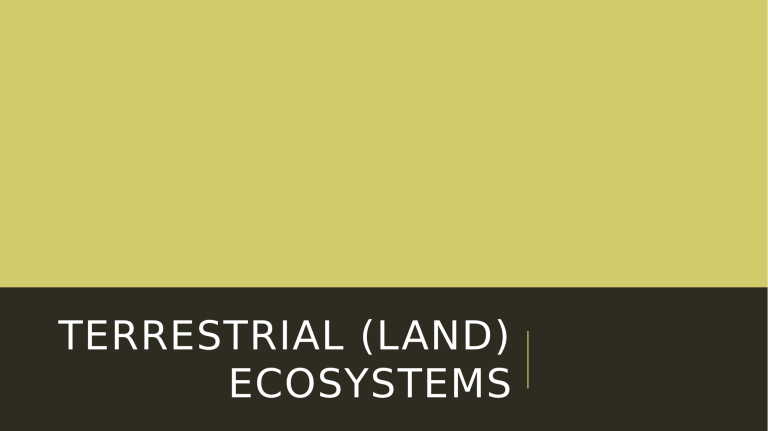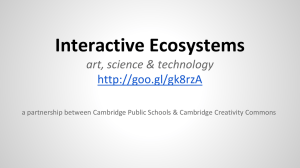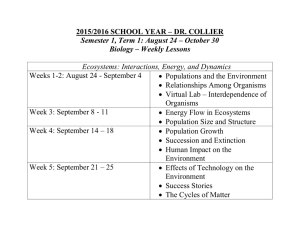
TERRESTRIAL (LAND)
ECOSYSTEMS
WHAT IS A BIOME?
A biome is a large region characterized by a specific type of
climate and certain types of plants and animals.
-- plants in each biome have different adaptations (size,
shape, water management, modified leaves, etc.)
-- climate (long-term weather conditions) and precipitation
(amount of rainfall) affect life in biome
-- latitude (distance north/south of equator) and altitude
(height above sea level) affect biomes and their inhabitants
TROPICAL RAIN
FORESTS
-- Are characterized by high
temperature (red) and heavy
rainfall (green).
-- Low nutrient soil (plants take
up nutrients quickly)
-- Biome with the highest
biodiversity (most different
species)
-- Typical animals include
monkeys, lizards, snakes, and
birds (specialists that use
resources in specific ways)
LAYERS OF THE RAINFOREST
Four layers:
1. Emergent layer – top layer
with the tallest trees
2. Upper Canopy – Receives
more light
3. Lower Canopy – Receives
less light [has plants called
epiphytes (plants that live on
other plants) and vines]
4. Understory – Very little
light reaches this level. Small
plants
Threats to Rainforest:
-- habitat destruction
-- deforestation
-- illegal animal/plant poaching
& trading
TEMPERATE DECIDUOUS
FORESTS-
-- Have warm summers and cold winters (red), moderate
precipitation (green), and rich soil with decaying organic matter
and worms and fungi.
-- Have four seasons (winter, spring, summer, & fall {where
trees lose leaves}
-- Contain deciduous trees that shed their leaves during the
winter (beech, birch, maple, oaks, and willows), an adaptation
TAIGA
-- Winters are cold, and
precipitation is in the form of
snow.
-- Soil is low in nutrients and
highly acidic
-- Are characterized by
coniferous forests (pines, firs,
and other trees with
needles).
-- Hares, lynx, wolves, foxes,
etc.
SAVANNA
S
-- Subject to high
temperatures (red), and low
rainfall (green).
-- Are tropical-subtropical
grasslands with scattered
bushes and trees.
-- Animals include long-legged,
hoofed herbivores (like bison,
antelopes, cattle, and zebras).
-- Have a wet season & a dry
season
TEMPERATE
GRASSLANDS
-- Receive less water
and are subject to
lower temperatures
than are savannas.
-- Grasses and
wildflowers
-- Most fertile soil in
the world
DESERTS
-- Are hot and dry
-- Widely scattered vegetation & little rain
-- Soil is sandy and nutrient poor
-- Plants have adapted to the hostile
conditions: leathery leaves, deciduous
leaves, or leaves reduced to spines
(cacti).
-- Animals: have thick skins, conserve
water by producing no urine or very
concentrated urine, and/or restrict their
activity to nights.
-- Estivating – burying in ground and
sleeping through dry season (amphibians)
TUNDRA
Is extremely cold and dry
Short growing season &
permafrost (permanently
frozen soil)
During the summer, the
thawing topsoil supports
a grassland type
community with grasses,
sedges, mosses and
other vegetation tolerant
of soggy soils
Animals include caribou,
musk oxen, owls,
lemmings, hares, and
FRESH WATER
ECOSYSTEMS
Chapter 7
PLANKTON
Plankton - organisms that cannot swim against
currents (drifters).
Two types:
1. Phytoplankton - Drifting algae (food base for
most aquatic ecosystems).
2. Zooplankton -- Drifting animals
Nekton – free swimming organisms (fish, whales,
etc.)
Benthos – bottom-dwellers (mussels, barnacles,
etc.)
LAKES & PONDS
Wetlands – an area of land that is
periodically underwater or whose soil
contains a great deal of moisture
Lakes & ponds are split into zones:
1. Littoral zone – nutrient rich; near the
shores (diverse life like cattails, water lilies,
2. Limnetic zone – no rooted plants;
phytoplankton
3. Benthic zone – bottom of lake/pond;
decomposers live off of dead plants/animals
EUTROPHICATION
Eutrophication -- an increase in the
amount of nutrients in a body of water.
As the plants & algae multiply, the
number of bacteria feeding on the
decaying organisms also grows.
Bacteria use the oxygen dissolved in the
lake water, killing oxygen-loving
organisms.
Process can be accelerated by runoff -precipitation carries pollutants like
fertilizers from land into bodies of water
FRESHWATER WETLANDS
Freshwater wetlands -- areas of land, with special soils & plants,
that are covered with fresh water for at least part of the year.
The two main types: marshes and swamps
-- Act as filters; they absorb & remove pollutants from the water
that flows through them (improve the water quality of lakes,
rivers, & reservoirs downstream).
-- Control flooding by absorbing extra water when rivers overflow;
protects farms and urban and residential areas from damage.
-- Used for fish feeding/spawning grounds, homes for native &
migratory wildlife, and vegetation helps trap carbon
MARSHES
Marshes tend to occur on low, flat lands
and have few, if any, woody trees or
plants (have reeds, rushes, and cattails)
-- Have nutrient-rich benthic zones
-- Contain plants, algae, & numerous
decomposers
-- Home to many types of water fowl &
migratory birds from temperate and
tropical habitats.
-- Various salinity. Freshwater, brackish
water, or salty water.
SWAMPS
Swamps occur on flat, poorly
drained, wooded land, often
near streams.
-- Organisms depend on salinity
and climate tolerance.
Freshwater swamps include
acidic bogs (cold climates) and
cypress swamps (warm
climates)
-- Ideal habitat for amphibians
(like frogs), birds, and alligators
HUMAN IMPACT
Wetlands were considered
wastelands & breeding grounds
for disease-carrying insects.
Many have been drained, filled,
and cleared for farms or
residential and commercial
development
Vital as water purifiers, flood
preventers and habitats.
Gov’t & treaties protect many
wetlands, & most U.S. states
prohibit the destruction of
RIVERS
Rivers can originate from underground springs,
snow melt in mountains, or where smaller
streams merge together.
-- A river changes with the land and the climate
through which it flows.
-- Runoff materials affect the growth and health
of the organisms in the river.
-- Organisms include mosses, trout, minnow, etc.
-- Communities and industries affect the health
of rivers
-- Sewage disposal (pollution), toxin-ridden fish
(not edible) & dead organisms, &
pesticides/runoff poison rivers
Dams alter the ecosystems in/around a river
(alter flow, trap sediments, & change habitats)
SALT WATER
ECOSYSTEMS
Chapter 7
ESTUARIES
Estuary - an area in which fresh water from a river mixes with
salt water from the ocean.
As the two bodies of water meet, currents form and cause
mineral-rich mud and dissolved nutrients to fall to the bottom.
Tend to be very productive ecosystems because they constantly
receive fresh nutrients from the river
Receive light for photosynthesis (sunlight can reach bottom)
and abundant nutrients
Life includes: Plankton, rooted plants, otters, dolphins, oysters,
clams
Provide protected harbors, access to the ocean, and
connections to rivers (popular for major ports)
SALT WATER SWAMPS &
MARSHES
Mangrove Swamps
Salt Marshes
-- Mangroves (small salt-water
trees with above-ground root
systems)
-- Salt marshes form where
rivers deposit their load of
mineral-rich mud
-- Tropical and subtropical
zones.
-- Organisms include: a
community of clams, fish, and
birds.
-- Help protect the coastline
from erosion & reduce the
damage from storms.
-- Provide habitat for about
2,000 animal species
-- Acts as a nursery in which
many species of shrimps, crabs,
and fishes find protection when
they are small.
CORAL REEFS
Coral reefs are limestone ridges built by tiny coral animals
called coral polyps and the algae that live inside them.
Coral polyps secrete skeletons of limestone (calcium
carbonate), which slowly accumulate and form coral reefs.
Found in shallow, clear tropical seas. Home to thousands
of plant and animal species.
Their stinging polyps capture small animals that float or
swim close to the reef.
Fragile ecosystems – can’t be too
hot/cold/muddy/polluted/high in nutrients or algae will
leave or die.
This causes coral to turn white (bleaching) and the animals
& reef will die
Overfishing, climate change, oil spills, pollution runoff
impact reef
OCEANS
-- Majority of the ocean’s life is
concentrated in the shallow,
coastal waters (photosynthetic
organisms thrive like
phytoplankton & algae).
-- Open ocean is mainly
phytoplankton and zooplankton
in areas where there is enough
light and nutrients.
-- Deep ocean floor is mostly
decomposers, filter-feeders, and
chemosynthetic organisms.
-- Runoff from fertilized
fields, golf courses, or
suburban lawns may cause
algal blooms
-- Pollution and overfishing
destroying some fish
populations.
-- Trawl nets can entangle
organisms that are larger
than the holes in the nets
(like dolphins & sea turtles)
and drown them.






